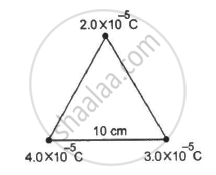Advertisements
Advertisements
प्रश्न
Check that the ratio ke2/G memp is dimensionless. Look up a Table of Physical Constants and determine the value of this ratio. What does the ratio signify?
उत्तर
The ratio of the electrostatic force to the gravitational force between an electron and a proton is
`(F_"elec")/(F_"grav") = (K_(e.e)/r^2)/((G m_e m_p)/r^2)`
= `(Ke^2)/(Gm_em_p)`
In terms of dimensions,
`[(Ke^2)/(Gm_em_p)] = [(F_"elec")/(F_"grav")]`
= `(MLT^-2)/(MLT^-2)`
= 1
Thus, the ratio `(Ke^2)/(Gm_em_p)` is dimensionless
`(Ke^2)/(Gm_em_p)`
= `(9 xx 10^9 xx (1.6 xx 10^-19)^2)/(6.67 xx 10^-11 xx 9.1 xx 10^-31 "kg" xx 1.67 xx 10^-27 "kg")`
= 0.23 × 1040
= 2.3 × 1039
That electrostatic forces are a factor of 1039 more than gravitational forces is indicated by this ratio.
APPEARS IN
संबंधित प्रश्न
The electrostatic force on a small sphere of charge 0.4 μC due to another small sphere of charge − 0.8 μC in air is 0.2 N.
- What is the distance between the two spheres?
- What is the force on the second sphere due to the first?
Find the dimensional formula of ε0.
At what separation should two equal charges, 1.0 C each, be placed, so that the force between them equals the weight of a 50 kg person?
One end of a 10 cm long silk thread is fixed to a large vertical surface of a charged non-conducting plate and the other end is fastened to a small ball of mass 10 g and a charge of 4.0× 10-6 C. In equilibrium, the thread makes an angle of 60° with the vertical. Find the surface charge density on the plate.
Suppose the second charge in the previous problem is −1.0 × 10−6 C. Locate the position where a third charge will not experience a net force.
Estimate the number of electrons in 100 g of water. How much is the total negative charge on these electrons?
Four equal charges of 2.0 × 10−6 C each are fixed at the four corners of a square of side 5 cm. Find the Coulomb's force experienced by one of the charges due to the other three.
Two identical pith balls, each carrying a charge q, are suspended from a common point by two strings of equal length l. Find the mass of each ball if the angle between the strings is 2θ in equilibrium.
Repeat the previous problem if the particle C is displaced through a distance x along the line AB.
A point charge produces an electric field of magnitude 5.0 NC−1 at a distance of 40 cm from it. What is the magnitude of the charge?
How much work has to be done in assembling three charged particles at the vertices of an equilateral triangle, as shown in the figure?
A total charge Q is broken in two parts Q1 and Q2 and they are placed at a distance R from each other. The maximum force of repulsion between them will occur, when ____________.
For charges q1 and q2 separated by a distance R the magnitude of the electrostatic force is given by ______.
Two identical thin rings, each of radius a meter, are coaxially placed at a distance R meter apart. If Q1 coulomb and Q2 coulomb are respectively the charges uniformly spread on the two rings, the work done in moving a charge q coulomb from the centre of one ring to that of the other is ______.
Two charges of equal magnitudes kept at a distance r exert a force F on each other. If the charges are halved and distance between them is doubled, then the new force acting on each charge is ______.
Coulomb's law is given by F = k q1q2 rn where n is
According to Coulomb's law, which is the correct relation for the following figure?

Which of the following statements about nuclear forces is not true?
What is meant by the statement: "Relative permittivity of water is 81"?
